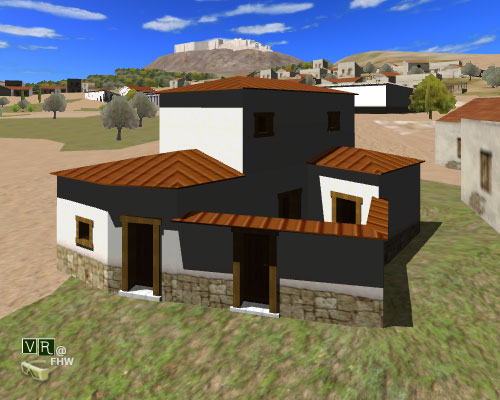Location: NW of the Middle Stoa and E of the Tholos, at the site were the Archaic landmarks (horoi) of the Agora were discovered (no. 10 in the Agora plan of the Guide: Mc CAMP II, J., The Athenian Agora: A Short Guide to the Excavations, Excavations of the Athenian Agora, Picture Book no 16, American School of Classical Studies, Princeton 2003, pp. 2 and 24-25).
Date of Construction: Late 6th cent. It is rebuilt in the 5th century.
Periods of Use: Classical
INTRODUCTION
This humble abode, situated on the Southwest corner of the Athenian Agora, was identified -thanks to a cup bearing an inscription on its stem- as the workshop of the Simon, the famous shoemaker and friend of Socrates, who used to frequent his shop and teach there.
CLASSICAL PERIOD
The House of Simon, excavated in 1953, is unimportant as a building but is connected to a very important figure, a person that left his mark on the Agora of Athens, Socrates. According the testimony of Diogenes Laertius, the philosopher used to frequent the workshop and dwelling of his friend, the simple cobbler Simon; Socrates often met conversed there* with his disciples, especially the younger ones who were not allowed to enter the area of the Agora. The provident craftsman noted down these conversations of Socrates (who is renowned for not having left behind him a single written word of his teachings) with his pupils, and later circulated thirty three of these in a book. These dialogues used to be called skytikoi (“the shoemaker’s”).
Apart from the inscription at the base of the black-coloured kylix (ΣΙΜΩΝΟΣ, in the genitive, denoting ownership), unearthed in the street just outside the house, the identification of this building as the workshop of Simon the shoemaker is supported by other finds discovered in the site: large tacks, which were possibly used for attaching the soles to boots, and bone grommets, which were probably used for the shoestrings.
The house belongs to a type particularly popular in Athens: its is irregularly shaped on the outside, in terms of plan. In all likelihood it consisted of a single storey. It contained two irregularly sized rooms which opened to a courtyard featuring a well and a cistern. Its dimensions are as follows: 12.80m (E-W) Χ 14.93m (N-S); the courtyard measures 5.48 Χ 6.40m. The excavation could not be completed, for the house is partly overlaid by the Middle Stoa. A landmark (horos) of the Agora was discovered in its original position very close to the House of Simon (today it is located inside the Middle Stoa).
Two phases can be distinguished in the house: the first dates to the Archaic Period, before 479, when the house was destroyed during the Persian invasion. At an unspecified time it was repaired and obviously it was in use during the last quarter of the 5th century, when it became one of Socrates’ haunts. The building material used in the first phase were clay bricks, while in the second phase, as was common in that period, limestone slabs were used. The floors were of compacted earth.
The area was cleared during the 2nd cent. BC, to make space for the construction of the Middle Stoa. But the house itself is unlikely to have survived for such a long period of time.
BIBLIOGRAPHY
BOERSMA, J.S., Athenian Building Policy from 561/560 to 405/404 B.C.,
Scripta Archaeologica Groningana 4, Wolters-Nordhoff Publishing, Groningen 1970, p. 247.
LANG, M.,
Socrates in the Agora, Agora Picture Books 17, Princeton, 1978.
Mc CAMP II, J.,
The Athenian Agora: A Guide to the Excavation and Museum, 4th ed., Athens 1990. pp. 56-58.
Mc Camp II, J.,
The Athenian Agora, A Short Guide to the Excavations, Excavations of the Athenian Agora, Picture Book no 16, American School of Classical Studies, Princeton 2003, p. 37.
Mc CAMP II, J.,
The Athenian Agora: Excavations in the Heart of the Classical City², Cambridge University Press 2001, pp. 177-181.
THOMPSON, D.B., “The House of Simon the Shoe-Maker”,
Archaeology 13 (1960), pp. 234-240. THOMPSON, H.A., WYCHERLEY, R.,
The Agora of Athens. The American Excavations in the Athenian Agora, vol. XIV, American School of Classical Studies at Athens, Princeton 1972, pp. 160-162.

House of Simon, Representation in VR environment

